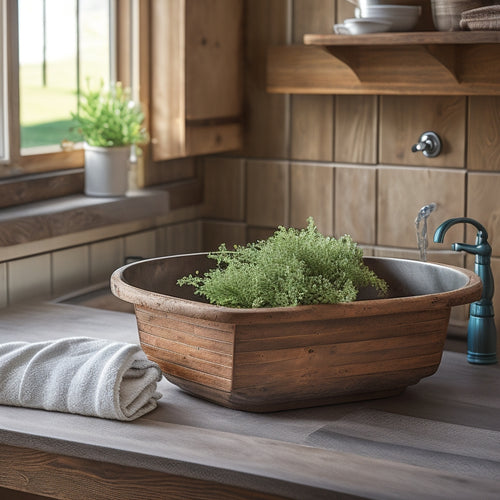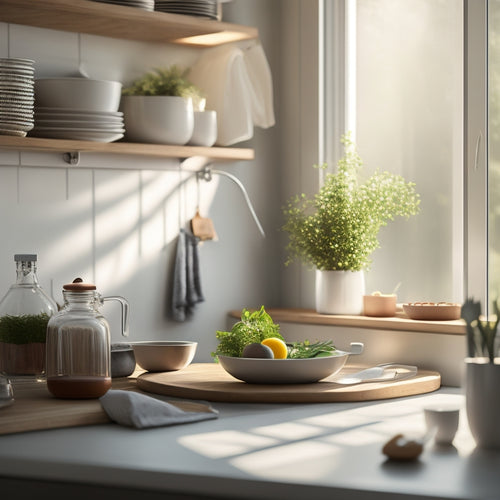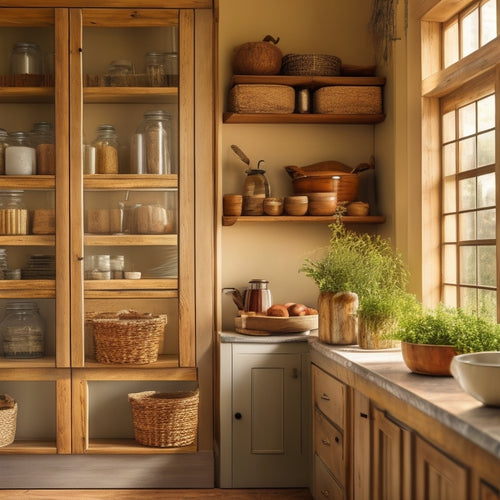
Designing a Clutter-Free Kitchen: Expert Guidance Online
Share
You're about to transform your kitchen into a clutter-free haven where every tool, ingredient, and appliance has its own designated spot. Start by implementing drawer dividers, introducing a color-coding system, and assigning labeled spots for appliances. Keep countertops clear for easy meal prep and save time with organized storage solutions. Next, maximize vertical storage space with shelving, hooks, and baskets, and optimize your kitchen workflow by strategically positioning tools and ingredients. Now, imagine moving through your kitchen with ease, where every zone is designed for efficiency - cooking, cleaning, and preparation areas all working in harmony.
Key Takeaways
• Implement a categorization system to group similar items together, assigning designated spots for easy access and visibility.
• Maximize vertical storage space with shelving, hooks, and pot racks to free up countertops and reduce clutter.
• Designate specific zones for food preparation, cooking, and cleaning to streamline workflow and maintain organization.
• Invest in countertop storage solutions like baskets, trays, and utensil organizers to keep surfaces clear and clutter-free.
• Optimize kitchen workflow by strategically positioning tools and ingredients, using space-saving solutions like retractable spice racks and overhead pot racks.
Kitchen Organization Fundamentals
As you stand in your kitchen, envision a space where every item has a designated home, and you can effortlessly locate the utensils, ingredients, and cookware you need to whip up a culinary masterpiece.
To achieve this, start by implementing drawer dividers to separate and categorize your kitchen essentials. This simple step will keep your countertops clear and make meal prep a breeze. Take it a step further by introducing a color-coding system, where similar items are stored together, creating a visual harmony that makes finding what you need a snap.
Next, tackle appliance storage by assigning a designated spot for each gadget and tool. A labeling system will help you quickly identify what's inside each cabinet or on each shelf, saving you time and reducing frustration.
Maximizing Vertical Storage Space
By installing shelves, hooks, or a pegboard on your kitchen's often-underutilized walls and ceilings, you can access a treasure trove of vertical storage space, keeping your countertops and floors clear of clutter. This strategic move not only frees up valuable real estate but also creates a sense of openness and airiness in the room.
To maximize your vertical storage space, consider the following:
-
Install vertical shelving solutions: From adjustable shelves to fixed units, these solutions provide ample storage for infrequently used items, keeping them out of the way but still accessible.
-
Utilize hanging storage: Hooks, baskets, and pot racks can be attached to walls or ceilings, providing a convenient spot to hang items like pots, pans, utensils, and even aprons.
-
Make the most of corner spaces: Don't let corner areas go to waste! Use carousels, lazy susans, or corner shelves to store items like spices, oils, or cookbooks, keeping them organized and within easy reach.
Streamlining Kitchen Workflow
With every step and gesture, you can optimize your kitchen workflow by strategically positioning essential tools and ingredients within easy reach, creating a seamless culinary experience. Efficient appliance placement is key to workflow optimization. Consider the 'golden triangle' concept, where your sink, stove, and refrigerator form the points of a triangle, allowing you to move effortlessly between tasks. This layout minimizes walking distances and maximizes productivity.
In a minimalist kitchen design, every inch counts. Space-saving solutions, such as retractable spice racks and slide-out trash cans, keep clutter at bay while keeping essential items within easy reach.
When designing your kitchen, think vertically – install overhead pot racks, hanging utensil organizers, or a pegboard to keep frequently used items off the countertops and out of the way.
Essential Kitchen Zones
Frequently, a well-designed kitchen is divided into distinct zones, each dedicated to a specific task, allowing you to navigate the space efficiently and cook with precision. By creating separate areas for different functions, you'll be able to prepare meals smoothly and enjoy a more organized cooking experience.
Here are three essential zones to include in your kitchen design:
-
Food Preparation Zone: This area should be equipped with ample counter space, hidden storage for utensils and ingredients, and a sink for efficient meal prep.
-
Designated Cooking Area: This zone should feature a cooktop, oven, and appliance storage, allowing you to focus on cooking without distractions.
-
Cleaning Zone: A designated area for cleaning, including a sink, dishwasher, and trash can, helps keep your kitchen tidy and organized.
Decluttering Kitchen Countertops
As you stand in your kitchen, visualize a clear expanse of countertop, uncluttered by appliances, gadgets, or miscellaneous items, and imagine the sense of calm and focus that comes with having a well-organized cooking space.
To achieve this, start by editing what's already on your countertops. Remove any items that don't belong or serve a purpose. Next, categorize items into groups, such as baking, cooking, and food preparation. Assign a designated spot for each group, ensuring easy access and visibility.
Invest in countertop storage solutions like baskets, bins, or trays to keep frequently used items within reach. Choose containers that complement your kitchen's aesthetic, incorporating minimalist decor principles. Consider a utensil organizer or a knife block to keep countertops clear.
Optimal Cabinet Organization
Now that your countertops are clear, turn your attention to the cabinets, where a thoughtful organization system can maximize storage capacity and make the most of every inch. You'll be amazed at how much you can fit in your cabinets with a little planning.
Here are three essential cabinet organization tips to get you started:
-
Assign a home for each item: Designate specific shelves or cabinets for specific items, such as baking supplies, cookware, or dinnerware. This will make it easy to find what you need when you need it.
-
Use drawer dividers and inserts: Divide your drawers into compartments to store utensils, spices, and other small items. This will keep them organized and prevent clutter from building up.
-
Install a spice rack: A spice rack on the back of a cabinet door or inside a cabinet can keep your spices organized and within reach, freeing up valuable shelf space.
Creating a Functional Pantry
By allocating a dedicated space for your pantry and strategically designing its layout, you can transform this often-chaotic area into a haven of efficiency and productivity.
A well-organized pantry is essential for smooth meal prep and food storage. To achieve pantry organization, start by categorizing your food items into groups, such as baking supplies, canned goods, and snacks. Then, assign a specific shelf or bin to each category, ensuring that frequently used items are easily accessible.
Consider installing adjustable shelves, baskets, or drawers to maximize storage capacity and keep contents visible. Label each section clearly, so you can quickly find what you need.
When it comes to food storage, think vertically – use stackable containers or baskets to store items like pasta, rice, or canned goods, keeping them off the floor and out of the way. By implementing these strategies, you'll be able to find what you need in a snap, making meal prep a breeze.
Designing a Clutter-Free Layout
You'll want to apply the same organizational mindset to the rest of your kitchen, starting with a clutter-free layout that directs your workflow and guides your movements. A well-designed layout should create a sense of harmony and efficiency, making it easier to cook, entertain, and socialize.
To achieve this, consider the following key elements:
-
Optimize your workflow: Design your layout to minimize walking distances and maximize counter space, ensuring that frequently used items are within easy reach.
-
Incorporate hidden storage: Utilize cabinets, drawers, and cleverly designed nooks to stash away appliances, cookware, and utensils, maintaining a minimalist decor that's both visually appealing and functional.
-
Balance open shelving and appliance storage: Showcase your favorite cookbooks, decorative pieces, or infrequently used items on open shelves, while reserving closed storage for bulky appliances and kitchen essentials.
Frequently Asked Questions
How Do I Maintain My Newly Organized Kitchen Over Time?
You'll maintain your newly organized kitchen by prioritizing long-term organization, time management, and consistent habits, preventing relapse by scheduling regular decluttering sessions and creating a routine that keeps your space tidy and functional over time.
Can a Clutter-Free Kitchen Still Be Aesthetically Pleasing?
You can absolutely create a clutter-free kitchen that's aesthetically pleasing by incorporating minimalist decor, functional storage, sleek appliances, and open shelving that showcase your favorite pieces, resulting in a beautiful, organized space that serves others with ease.
Are There Any Specific Kitchen Design Styles That Promote Clutter-Free Living?
You'll find that kitchen design styles with minimalist aesthetics and Scandinavian influence naturally promote clutter-free living, featuring clean lines, light-filled spaces, and clever storage solutions that create a sense of calm and serenity.
How Do I Involve My Family Members in Maintaining Kitchen Organization?
"Enlist your loved ones' help by making kitchen organization a fun, collaborative effort - assign tasks, create a 'clutter-busting' calendar, and celebrate small victories together, ensuring a sense of ownership and long-term family involvement."
Can a Small Kitchen Still Be Designed to Be Clutter-Free?
You can absolutely create a clutter-free small kitchen by maximizing space with strategic storage solutions, like wall-mounted shelves, pull-out cabinets, and multi-tiered countertops, to keep essentials within easy reach.
Related Posts
-

Sink Caddy Organizers for Farmhouse Style Kitchens
Sink caddy organizers are perfect for elevating your farmhouse-style kitchen while keeping it functional. You'll love...
-

Space-Efficient Dish Racks for Tiny Homes
Space-efficient dish racks are a game changer for tiny homes. By utilizing vertical storage, you can free up signific...
-

Freestanding Pantry Units for Farmhouse Kitchen Style
Freestanding pantry units perfectly blend beauty and function in your farmhouse kitchen. They maximize storage while ...


